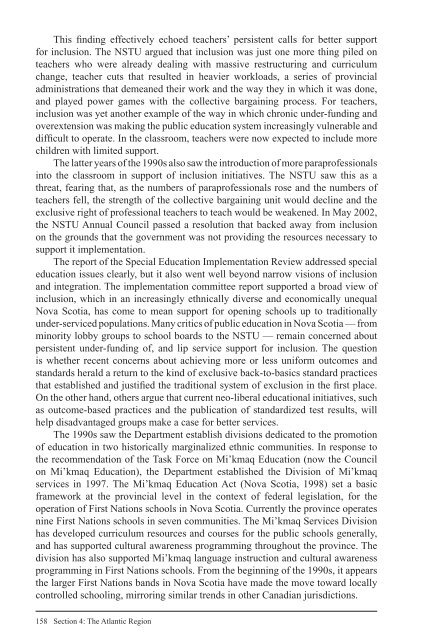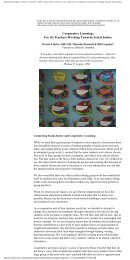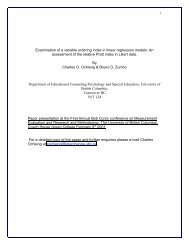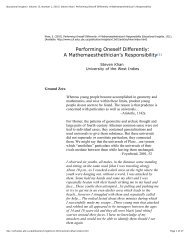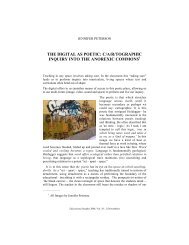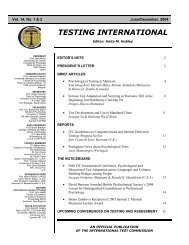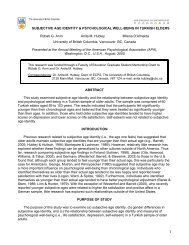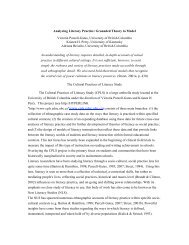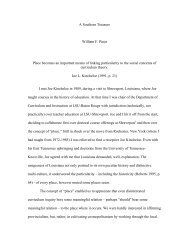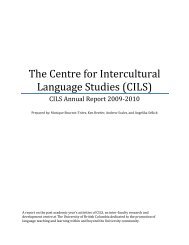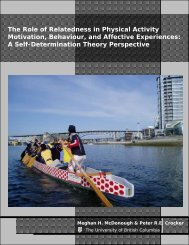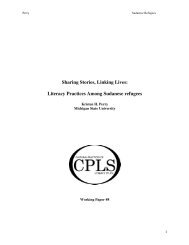The evolution of professionalism - Centre for Policy Studies in ...
The evolution of professionalism - Centre for Policy Studies in ...
The evolution of professionalism - Centre for Policy Studies in ...
You also want an ePaper? Increase the reach of your titles
YUMPU automatically turns print PDFs into web optimized ePapers that Google loves.
This fi nd<strong>in</strong>g effectively echoed teachers’ persistent calls <strong>for</strong> better support<br />
<strong>for</strong> <strong>in</strong>clusion. <strong>The</strong> NSTU argued that <strong>in</strong>clusion was just one more th<strong>in</strong>g piled on<br />
teachers who were already deal<strong>in</strong>g with massive restructur<strong>in</strong>g and curriculum<br />
change, teacher cuts that resulted <strong>in</strong> heavier workloads, a series <strong>of</strong> prov<strong>in</strong>cial<br />
adm<strong>in</strong>istrations that demeaned their work and the way they <strong>in</strong> which it was done,<br />
and played power games with the collective barga<strong>in</strong><strong>in</strong>g process. For teachers,<br />
<strong>in</strong>clusion was yet another example <strong>of</strong> the way <strong>in</strong> which chronic under-fund<strong>in</strong>g and<br />
overextension was mak<strong>in</strong>g the public education system <strong>in</strong>creas<strong>in</strong>gly vulnerable and<br />
diffi cult to operate. In the classroom, teachers were now expected to <strong>in</strong>clude more<br />
children with limited support.<br />
<strong>The</strong> latter years <strong>of</strong> the 1990s also saw the <strong>in</strong>troduction <strong>of</strong> more parapr<strong>of</strong>essionals<br />
<strong>in</strong>to the classroom <strong>in</strong> support <strong>of</strong> <strong>in</strong>clusion <strong>in</strong>itiatives. <strong>The</strong> NSTU saw this as a<br />
threat, fear<strong>in</strong>g that, as the numbers <strong>of</strong> parapr<strong>of</strong>essionals rose and the numbers <strong>of</strong><br />
teachers fell, the strength <strong>of</strong> the collective barga<strong>in</strong><strong>in</strong>g unit would decl<strong>in</strong>e and the<br />
exclusive right <strong>of</strong> pr<strong>of</strong>essional teachers to teach would be weakened. In May 2002,<br />
the NSTU Annual Council passed a resolution that backed away from <strong>in</strong>clusion<br />
on the grounds that the government was not provid<strong>in</strong>g the resources necessary to<br />
support it implementation.<br />
<strong>The</strong> report <strong>of</strong> the Special Education Implementation Review addressed special<br />
education issues clearly, but it also went well beyond narrow visions <strong>of</strong> <strong>in</strong>clusion<br />
and <strong>in</strong>tegration. <strong>The</strong> implementation committee report supported a broad view <strong>of</strong><br />
<strong>in</strong>clusion, which <strong>in</strong> an <strong>in</strong>creas<strong>in</strong>gly ethnically diverse and economically unequal<br />
Nova Scotia, has come to mean support <strong>for</strong> open<strong>in</strong>g schools up to traditionally<br />
under-serviced populations. Many critics <strong>of</strong> public education <strong>in</strong> Nova Scotia — from<br />
m<strong>in</strong>ority lobby groups to school boards to the NSTU — rema<strong>in</strong> concerned about<br />
persistent under-fund<strong>in</strong>g <strong>of</strong>, and lip service support <strong>for</strong> <strong>in</strong>clusion. <strong>The</strong> question<br />
is whether recent concerns about achiev<strong>in</strong>g more or less uni<strong>for</strong>m outcomes and<br />
standards herald a return to the k<strong>in</strong>d <strong>of</strong> exclusive back-to-basics standard practices<br />
that established and justifi ed the traditional system <strong>of</strong> exclusion <strong>in</strong> the fi rst place.<br />
On the other hand, others argue that current neo-liberal educational <strong>in</strong>itiatives, such<br />
as outcome-based practices and the publication <strong>of</strong> standardized test results, will<br />
help disadvantaged groups make a case <strong>for</strong> better services.<br />
<strong>The</strong> 1990s saw the Department establish divisions dedicated to the promotion<br />
<strong>of</strong> education <strong>in</strong> two historically marg<strong>in</strong>alized ethnic communities. In response to<br />
the recommendation <strong>of</strong> the Task Force on Mi’kmaq Education (now the Council<br />
on Mi’kmaq Education), the Department established the Division <strong>of</strong> Mi’kmaq<br />
services <strong>in</strong> 1997. <strong>The</strong> Mi’kmaq Education Act (Nova Scotia, 1998) set a basic<br />
framework at the prov<strong>in</strong>cial level <strong>in</strong> the context <strong>of</strong> federal legislation, <strong>for</strong> the<br />
operation <strong>of</strong> First Nations schools <strong>in</strong> Nova Scotia. Currently the prov<strong>in</strong>ce operates<br />
n<strong>in</strong>e First Nations schools <strong>in</strong> seven communities. <strong>The</strong> Mi’kmaq Services Division<br />
has developed curriculum resources and courses <strong>for</strong> the public schools generally,<br />
and has supported cultural awareness programm<strong>in</strong>g throughout the prov<strong>in</strong>ce. <strong>The</strong><br />
division has also supported Mi’kmaq language <strong>in</strong>struction and cultural awareness<br />
programm<strong>in</strong>g <strong>in</strong> First Nations schools. From the beg<strong>in</strong>n<strong>in</strong>g <strong>of</strong> the 1990s, it appears<br />
the larger First Nations bands <strong>in</strong> Nova Scotia have made the move toward locally<br />
controlled school<strong>in</strong>g, mirror<strong>in</strong>g similar trends <strong>in</strong> other Canadian jurisdictions.<br />
158 Section 4: <strong>The</strong> Atlantic Region


